Golden Gobi Grizzlies
Air Date: Week of February 3, 2017
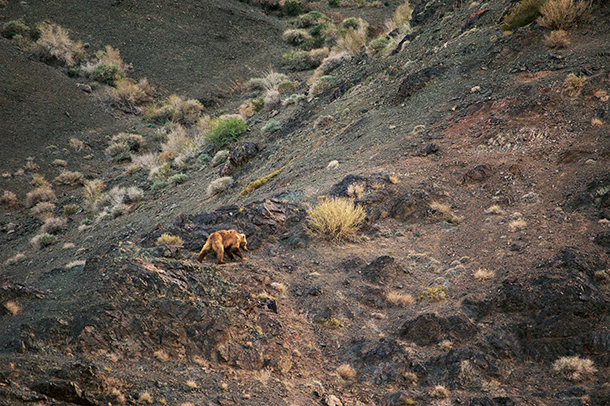
A Gobi Grizzly negotiates a dry rocky slope (Photo: Joe Riis)
Just a few dozen grizzly bears with bright yellow coats live in the forbidding Gobi Desert in Mongolia. Living On Earth Host Steve Curwood spoke with writer and wildlife biologist Douglas Chadwick -- who has returned to the Gobi desert season after season to track these astonishing bears -- about how they survive and what can be done to better protect them.
Transcript
CURWOOD: Grizzly bears can be huge and fearsome beasts, not to be messed with when you're out in wild country. Their range extends across western North America and through much of Asia. There’s even a tiny population of grizzly bears that roams the Gobi Desert in Mongolia, notable for their shocking coats of bright gold fur.
Wildlife biologist and writer Douglas Chadwick spent many seasons with a team traveling in the Gobi, to photograph and learn more about these creatures that seem to defy all odds. His new book is "Tracking Gobi Grizzlies", and he joins us now. Welcome to Living on Earth.
CHADWICK: Thank you. Glad to be here.
CURWOOD: Hey, tell me about your fascination with grizzly bears. In your book you explain that your interest in Grizzlies began way before you arrived in the Gobi. What sparked that fascination?
CHADWICK: Well, I was like most people, Steve. I knew of the stories. I knew the “There I Was” movies, the little pioneer girl getting chased by the big bear. I carried a big .44 Magnum on my hip and worried a lot when I first started hiking in bear country. And one day I watched three bears. It was a mother sliding down a snow bank in the summer. It was a hot afternoon. I had been doing the same thing. And then she went back up to the top of the snowbank and put her two cubs on her lap and slid down on her back with them, and then they went up and did it again. And this went on for about 20 minutes and by the end of that I said, "I like these people. I want to know more about them. I don't think the stories and everything I've been told has given me any kind of reasonable picture of one of the master mammals out here with me.”
Douglas Chadwick chronicles his desert adventures in his new book, “Tracking Gobi Grizzlies: Surviving Beyond the Back of Beyond.” (Photo: Elena Meredith)
CURWOOD: [LAUGHS] Now, how did you learn that there was a population of grizzly bears living in the Gobi Desert of Mongolia? I mean, this is, you know, a lot of rocks and expansive deserts, not a place that I think of grizzlies.
CHADWICK: Not a place I would have thought of grizzlies. And I was thinking about bears while I was hiking in northwestern Mongolia in the mountains in a place that looked a lot like Montana with forests and glaciers up above on the border of Russia and Kazakhstan. And I was tracking Snow leopards on a story for National Geographic. And my translator, who’s a woman working for the Snow Leopard Trust, told me while we weren't seeing any brown bears, which are the same as grizzly bears, and I had expected we might because we were hot on the trail of snow leopards. There were ibex watching us from the cliffs as it was just that kind of place, but the bears had been pretty much shut out. And she happened to mention, "Well, we also got these other grizzly bears in Mongolia.” And I said, "Where?" And she said, "In the Gobi Desert." And I said, "We've got a communication problem. I thought you just told me there were grizzly bears living in the Gobi Desert." And she said, "My father happens to be the director of the Great Gobi Strictly Protected Area, and he has studied them for 30 years.” And I said, "OK. Next question is, how many of these kinds of bears are there in Mongolia?" And she said, "About 30." I said, "Now that's in Mongolia. How many are there?" and she said "They're all in Mongolia and nowhere else. There are 30 Gobi grizzly bears left in the world."
CURWOOD: So, then you had to go. So, describe to me the first time you actually got to sight a Gobi grizzly in the wild, and how did you react?
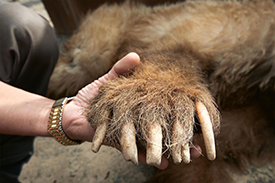
The front claws of a Gobi bear that move across that same rock terrain month after month. (Photo: Joe Riis)
CHADWICK: Well, it's small and lean compared to our North American grizzly bears. It has wildly mussed up - I call it bed hair - sticking out all over the place and is very much a grizzly. We would catch them in a box trap in order to place satellite radio collars on them. And yet even a tranquilized Gobi grizzly, it was clear to me the power of the bear is the same as the ones we live with here, and certainly, as it came out of the drug, it started smashing up the trap and then proceeded to chase off a large van full of Mongolians and a couple of Americans that was five times its size. I said, "Yes, that's a grizzly."
But it smelled sweet. It smelled like dust. It smelled like plants that it had been digging. Its breath was warm. It had these stubby claws that said at a glance, “I have been walking on rocks all my life, and I have been digging through gravel to find roots, and I am a beat-up, thirsty, dusty bear on the outer edge of possibility, but I'm here”.
CURWOOD: So, why were you in the Gobi at that time, by the way?
CHADWICK: I had been invited to come down and join a research team of Americans and Mongolians, small group. I joined in 2011. I intended to just go over and learn about these bears and write about them based on one season. And the season is after they wake up in the spring and before June arrives because by then it's getting to be close to 100 [degrees] in the day, and any animal captured in a trap is the subject to heat stress. So we’d quit, and we’d go home. The project leader and others go back again to the Gobi in the fall and just simply track the animals. But I went over for five springs in a row and spent a month there camped out, not sure where I was half the time, but camped out somewhere, where we could access three or four oases, set up traps there and then spend the day tracking them through the countryside, observing other wildlife, finding out these little details, like Gobi bears often drink from pools that have been dug by the wild asses with their sharp hoofs. So if you're not saving wild asses you may not be able to save Gobi bears.
CURWOOD: You mentioned that they're small. Why are they so small?
CHADWICK: It's pretty hard to get big on a diet of wild rhubarb, wild onions, lizards, beetles, occasionally scavenging the carcass of a larger animal, but everything is few and far between, both plants and animals. And that number I gave you, 30, is probably an underestimate. It looks as though there are three to possibly four dozen, and it also looks as though they have been increasing very slightly since the study started in 2005.
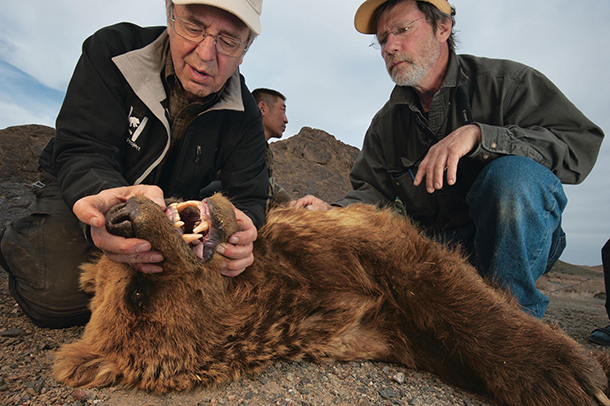
Gobi Bear Project leader Harry Reynolds (left) and Michael Proctor check the mouth of a captured male. Tooth pattern and sharpness are good indicators of a grizzly’s age, but in the Gobi, estimates are adjusted to account for wear and tear from gravel and sand when foraging for roots, insects, and burrowing rodents. (Photo: Joe Riis)
CURWOOD: So, talk to me about the harsh environment, the outdoor environment there in the Gobi. It’s so dissimilar from the ones where nearly every other grizzly population is located. In the warm time of year, it could be, what, 120 degrees? And in the winter, it can be, what, minus 40, huh?
CHADWICK: It can be minus 40 with a heck of a wind coming off the Gobi Altai Mountains, and the bears do hibernate there, and their cycle is a lot like the one you’d find here with the bears in Montana in Glacier Park.
CURWOOD: So, Doug, there are just perhaps as many as three dozen, maybe four dozen of these bears. That's not many bears. Originally, how many would there have been there, and what happened?
CHADWICK: You know, it's a little like asking how many bison or how many grizzlies used to be in North America. Nobody knows because we blew through them so quickly. And there are estimates, and that's all you can have. And look, Gobi bears were not discovered or proven to exist until 1943, and that's simply a tribute to the size of the Gobi and the difficulty of living there and the fact that it was still just barely beginning to be explored around the early 1900s, and the Gobi bear was a myth. It was like Bigfoot or Sasquatch or something. There was something big and hairy roaming around out there that occasionally walked on two legs. And so I can't give you the number of how many would've been around. I doubt it was in the thousands, but it might have been.
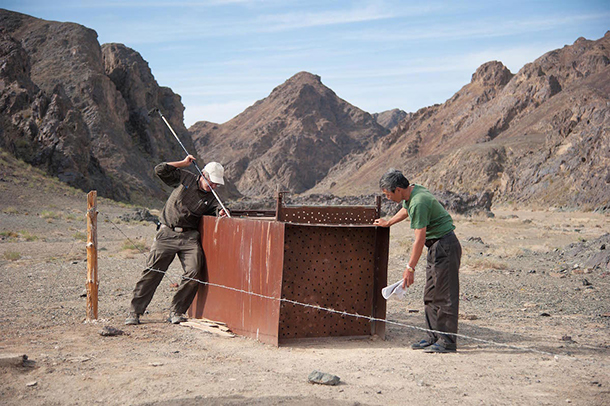
Harry Reynolds sedates a captured bear. (Photo: Joe Riis)
CURWOOD: I understand that the pilot conservation project helps the bears by feeding. How exactly do you feed a grizzly?
CHADWICK: Well, first of all I spend a lot of time in Montana working with biologists and state and federal agency people going around telling people, “Please do not feed the bears.” And a fed bear is a dead bear because it learns to get food near humans and that's not a good strategy for staying alive. And suddenly I find myself not only in the back-of-beyond, riding around in a Russian-made van with a small herd of Mongols wondering what I'm doing, but we're going out to feed grizzly bears.
What you do is dump sacks of livestock chowder, or chow, into a big bin with a trough on the bottom and put it near the oasis. They don't depend on it, but there's a lot of drought years, and it's not getting any better in a warming, drying climate.
CURWOOD: Doug, how is the Mongolian government responding to these conservation efforts for the Gobi grizzlies?
CHADWICK: The Mongolian government...The best way to say this is, in 2013, the Mongolian declared that the year of the Gobi bear, which they call Mazaalai. And there were, there's even a Mazaalai vodka you can buy, and there's Mazaalai bread. And they know about the golden grizzlies of the Gobi Desert, and they want to preserve them. It's just that nobody had any... OK, we all want to save them. How? What do they need? What can be done? They've improved some of the water sources. They've got some solar-powered pumps that work. They've even tried cloud-seeding in the area. We work with University scientists from Mongolia. We've had the Minister of the Environment come down and join the team. They're more than willing to help.
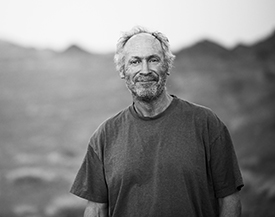
Douglas Chadwick is a wildlife biologist and author with a love for grizzly bears. (Photo: Joe Riis)
CURWOOD: So, how well are these efforts going?
CHADWICK: Um, how it's going is the story I really wanted to tell, and that was the main incentive for the book. It’ss on the upswing, and some of the happiest moments of my life have been standing out even in a duststorm and bitter cold winds, but checking the images on the automatic camera set up near the feede. And as you scroll through them, all of a sudden there are two baby bears with their mom, so they are reproducing.
We're also finding more bears. The way you count them is...Obviously you're not going to cover an area five times the size of Yellowstone Park…but you can collect hair, and that count is going up by the year. So, it's very encouraging. And recently the Mongolian government just set aside a large reserve. It links this great Gobi Strictly Protected Area, where all the last bears are, through this new reserve to Gobi Gurvan Saikhan, which means Three Jewels National Park. And that is a bit wetter. It's got more vegetation, and it is a former range of the bears. And if they can connect through there, back into that former range, I think they'll do well.
Really, this story isn't just about, how do you save a Gobi bear? It's, how could you turn your back once you know they're there? You have to help somehow. That's how I felt. But more importantly, it's, like, if we can pull this off, it says something about all those big animals out there, so many of which are at risk around the world.
CURWOOD: Douglas Chadwick is a wildlife biologist and author of "Tracking Gobi Grizzlies". Doug, that's so much for taking the time with us today.
CHADWICK: Well, thank you so much for the time, and I don't know how else Gobi bears are ever going to be heard about or known by the rest of the world, and I'm glad for the opportunity. Thank you.
Links
Tracking Gobi Grizzlies book website
Douglas Chadwick for National Geographic: “Can World’s Rarest Bear Be Saved?”
IUCN lists Grizzly bears as a whole as “Least Concern”, though some local populations are declining
Living on Earth wants to hear from you!
Living on Earth
62 Calef Highway, Suite 212
Lee, NH 03861
Telephone: 617-287-4121
E-mail: comments@loe.org
Newsletter [Click here]
Donate to Living on Earth!
Living on Earth is an independent media program and relies entirely on contributions from listeners and institutions supporting public service. Please donate now to preserve an independent environmental voice.
NewsletterLiving on Earth offers a weekly delivery of the show's rundown to your mailbox. Sign up for our newsletter today!
 Sailors For The Sea: Be the change you want to sea.
Sailors For The Sea: Be the change you want to sea.
 The Grantham Foundation for the Protection of the Environment: Committed to protecting and improving the health of the global environment.
The Grantham Foundation for the Protection of the Environment: Committed to protecting and improving the health of the global environment.
 Contribute to Living on Earth and receive, as our gift to you, an archival print of one of Mark Seth Lender's extraordinary wildlife photographs. Follow the link to see Mark's current collection of photographs.
Contribute to Living on Earth and receive, as our gift to you, an archival print of one of Mark Seth Lender's extraordinary wildlife photographs. Follow the link to see Mark's current collection of photographs.
 Buy a signed copy of Mark Seth Lender's book Smeagull the Seagull & support Living on Earth
Buy a signed copy of Mark Seth Lender's book Smeagull the Seagull & support Living on Earth

